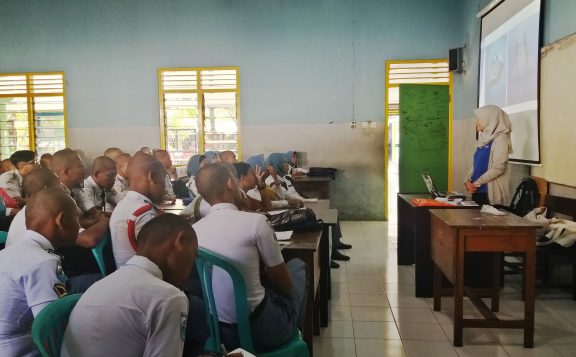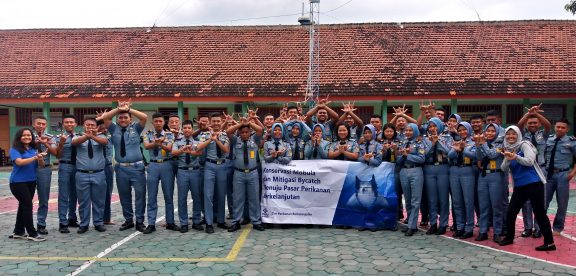On February 8 our Sustainable Fisheries team took their education and outreach programme to SMKN 1 Glagah in Banyuwangi. Eighty-four fishery high school students attended the seminars, where they increased their knowledge about mobulid ray conservation, bycatch mitigation, and sustainable fisheries and seafood markets.
SMKN 1 Glagah is the first high school we have visited outside Muncar, and represents an important expansion of our education and outreach programme. The school was established in 1980 as a vocational high school, and today offers four maritime programs: fishery agribusiness, fishery processing technology, fishing vessel engineering, and fishing vessel navigation. On this visit, we were welcomed by Pak Suharyanto, a teacher within the maritime department, who introduced us to students from fishery agribusiness and fishery processing technology courses.
Our first seminar was with 43 students from the 10th grade. After introducing MantaWatch, we went on to share important and interesting facts about mobula ray conservation, bycatch mitigation, and sustainable seafood markets. The students could all recognise mobulas as a ray species, and even told us about some of the local ray cuisines. The surprising facts about declining populations and the threats facing mobula rays caught their attention. As first-year students, this was new information, and many were unaware of sustainability issues or that some marine species have low reproductive rates. With overfishing and bycatch preventing mobulas and other threatened species reaching maturity and reproducing, the students were concerned that mobula rays may face extinction. They were intrigued and enthusiastic to learn about our work evaluating whether light can reduce mobula bycatch.

SMKN 1 Glagah 10th-grade students discuss the differences between mantas and mobula with Vidlia Rosady, Sustainable Fisheries Coordinator
Next, we held a seminar with 41 students from the 12th grade, who were all familiar with the production of high-quality fishery products and mobula ray identification. The students posed interesting questions and discussions, including whether aquaculture could be used to satisfy the demand for mobula rays products while reducing threats on wild populations, the important issue of local food security, and why MantaWatch is focusing on this issue in Banyuwangi. This provided a great opportunity to compare the advantages and disadvantages of mobula rays culture and harvest compared to other fishery products, and to introduce the global and national initiatives, frameworks and laws related to mobulid ray fisheries and conservation. The students had a chance to watch videos of mobulas and mantas in the wild, and to discuss their behaviours. They were fascinated, and all wanted to have a chance to see mantas and mobulas in real life.

SMKN 1 Glagah’s 12th-grade fishery agribusiness and fishery processing technology students show their support for mobula conservation
Local vocational schools like SMKN 1 Glagah play an important role developing essential knowledge and skills to support local development. Banyuwangi’s economy depends on the fishery. As the city has grown, many industries and small businesses have developed to produce not only raw material but also high quality processed fishery products. This development requires human resources that have technical skills, as well as knowledge about managing natural resources sustainably for long-term growth.
The students we met at SMKN 1 Glagah are the future of Banyuwangi’s fisheries sector. Our education and outreach programme aims to encourage students to consider that, to increase the sector’s economic value, businesses must not only improve the quality of their fishery products but also take an active role in maintaining the ecosystems that underpin local jobs and livelihoods.
SMKN 1 Glagah is the first high school we have visited outside Muncar. We hope that this is just the first step in expanding our education and outreach programme, and sharing our bycatch mitigation work with a wider audience.


